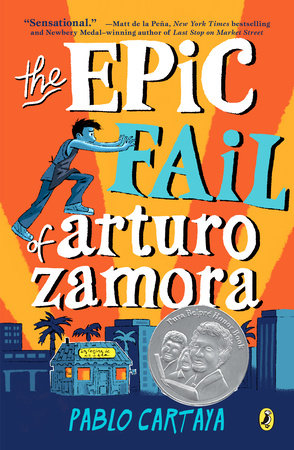The Epic Fail of Arturo Zamora by Pablo Cartaya, 240 pp, RL 4
The Epic Fail of Arturo Zamora
Review Copy from Penguin Random House
Story: Miami native Arturo Zamora is thirteen the summer things change for him and his family. Immigrants from Cuba, Arturo's grandparents opened La Cocina de la Isla twenty years earlier in their Canal Grove neighborhood. Almost all of Arturo's aunts, uncles, and cousins have worked at La Cocina and they continue to gather every Sunday, when the restaurant closes, for family dinner. And the neighborhood loves La Concina, too. Photos of celebrations held at the restaurant over the years adorn the walls. But, when unscrupulous developer Wilfrido Pipo comes to Canal Grove with the promise of prosperity for all in the name of a high rise on the very land where La Cocina sits, the Zamoras begin to worry. With the help of Carmen, a family friend visiting from Spain, Arturo investigates Pipo and his plans for gentrification, as well as the validity of the promises he is making the residents of Canal Grove as he woos them with parties and prizes.
Arturo finds inspiration from his long-deceased abuelo and namesake, who left him a box of letters sharing the story of his life in Cuba, how he met his future wife, and how he found direction from the Cuban poet José Martí. His abuelo leaves Arturo a final letter that is blank except for the words, WRITE HERE. And Arturo does, finding his voice when he needs it the most.
Why Read? Why Buy?: Besides bringing much needed diversity to the world of middle grade novels, The Epic Fail of Arturo Zamora is a magnificent story of the importance of family, community and connection. The food of La Cocina de la Isla sustains the body while poetry feeds the soul. Cartaya makes this digestible for young readers through the story of a boy who, through the loss of his abuela and the threat of the loss of his family's livelihood, comes to see that community, along with, "el amor y la fe," love and faith, are not only important but worth speaking up and speaking out for. I especially loved the use of the Spanish language and Cuban foods and ingredients throughout the novel. While there is no glossary, Cartaya usually makes it clear what is being said. Best of all, there is a recipe corner at the end of the novel with details on how to make the mouthwatering dishes described in the novel!
New from Pablo Cartaya!




